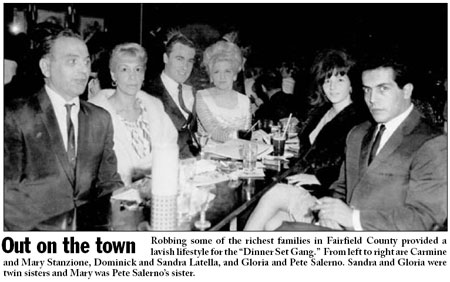Fairfield County Duo Set Standard for Cat Burglars
| By CHANDRA NILES FOLSOM, Correspondent |
They could hear the barking of dogs closing in on them and finally decided to just sit back and wait for the inevitable. It was long overdue.
“It was cold—there was snow on the ground and we were in a box,” said Dominick Latella, recalling his capture following the last cat burglary he attempted with partner Pete Salerno. “I looked at Pete and said, ‘this is it.’ So we sat with our backs against a tree until the dogs came.”
It was the end of a 30-year run—a string of high-end burglaries that finally landed Latella and Salerno in prison — but not before stealing an estimated $75 - $150 million in cash and jewelry from some of the nation’s wealthiest families including the DuPonts, Gimbels, Macys and Pillsburys, taking on average a quarter-million dollars per job. Dubbed by the press as the “Dinner Set Gang” and the “Fat Cat Burglars”, the pair was finally brought to justice on January 21, 1992, on Clapboard Hill Road, in Westport.

Latella and Salerno were more than just partners in crime. The two married Gloria and Sandra Savino—identical twin sisters from a mob-connected family in New York. They committed amateur burglaries before developing a modus operandi that allowed them to slip in and out of mansions undetected.
“They stole while people were at home eating dinner,” said Dick Atkins, who is currently producing a film about Salerno and Latella. “Their tactic was actually common-sense—if counterintuitive. If people were at home, their alarms were turned off. And if they were eating dinner, their best jewels would be in the master bedroom suites, instead of on their wrists and around their necks.”
By Land or Sea
They traveled by land or sea. Beachfront mansions were often approached by raft. After committing their burglaries, the team would push off the shoreline and be miles away before homeowners ever knew what had hit them.
“Their heyday was during the late 1960s and early 1970s, when they robbed mansions that had never been robbed before, but they knew if they were going to be successful, they must be careful,” said Atkins. “If the situation didn’t look right they walked away—they were non-confrontational and never brought weapons.”
Salerno would scale the houses—entering usually through a second story window—while Latella waited outside in the bushes, watching the dining room carefully to make sure nobody left the table, and keeping an eye on the driveway. If anything went awry, he’d blow a whistle to alert his cohort and they would flee the scene, undetected. They hit New England during warm months, when foliage provided good cover, and worked the sunbelt in the winter, following the wealthy in their seasonal travel.
Cops Close Behind
But the cops were always just a few steps behind them.
“I had been investigating other burglaries in mansions,” said retired Westport Police Detective Mike Barrett, who now runs Barrett Investigation, LLC, in Westport. “The local precincts held burglary meetings where we’d swap notes and keep each other apprised of crimes in the area.
The police found that similar burglaries had been committed in Palm Beach County, Florida— where the team sometimes followed the families and their jewels to vacation homes. The robbers did research at local libraries—often gleaning information about the rich and famous from “Who’s Who,” “Town & Country,” “Forbes,” and “Architectural Digest” magazines. The magazines were excellent references for lifestyles and floor plans.
“I was appointed to the detective division in 1975,” said retired Greenwich Police Officer Jim Hirsh, now director of security for the Tudor Investment Group, in Greenwich. “At the same time, Detective James Smith, who had been spearheading the burglaries, handed me a book he’d been keeping on them and said, ‘Here—you will be handling this at some point.’”
The book came in handy. Along with his partner Peter Hansen, Detective Barrett and officers from Westchester and Putnam Counties collected bits and pieces about the mysterious cat burglars that led them up and down the Atlantic coastline.
Loved Fairfield County
“We loved Fairfield County,” said Salerno—currently serving a sentence for an unrelated crime in Florida. “We hit a ton of houses in Greenwich, New Canaan, Darien and Westport. We wanted only the biggest and the best so we picked our targets. In Greenwich, we hit the Gimbel Estate, called Chieftans, in 1970. We scouted out the area first. It took me more than three minutes to run across the property so I figured it was a half-mile wide.”
Where there was no water access, the team used a driver—usually the husband of Salerno's sister, Carmine Stanzione, who would meet them miles away from any potential witnesses.
“Pete wasn’t tall, but he was built like a brick house,” said Atkins. “When the money and jewels were in a safe, if he couldn’t crack it, he’d pick it up and hurl it over the balcony, where he and Dominick would drag it far away from the house and pry it open.”
Success for the Dinner Set Gang came with perks—they drove a Rolls Royce and wore $500 suits. Their wives kept $20,000 at a time in envelopes—spending lavishly on whatever caught their fancy. Most of the cash was provided by the gang’s main fences —Wally and Flo Gans— a couple who ran a shop in Manhattan’s 47th Street diamond district. Their biggest score—valued at $12 million was at a DuPont Palm Beach rental property, where Pete found a leather traveling case in a linen closet containing, among other items, a 17.65-carat flawless pink diamond, valued at $1.8 million, according FBI reports.
“Me and Dom lived under assumed names on Indian Field Road, in Greenwich for about six months in 1970,” said Salerno. “We loved that area until the cops in Greenwich picked us up and charged us with vagrancy.”
Left Few Clues
Because the Fat Cats left few clues—even tossing their shoes onto the highway afterwards in case footprints were left behind—the police were unable to pin anything on them, even though they had strong suspicions about their identities and activities.
“I was driving my Cadillac El Dorado with Florida plates and $1,800 in cash,” Salerno added. “The judge said to the cops, ‘so are you arresting rich vagrants, now?’ That’s when the Lieutenant gets me aside and says, ‘don’t bother us here anymore. Before you came these people were virgins. Please leave us alone.’ So they escorted me to the state line and let me go.”
The following month, the Greenwich police picked up Latella at the local A&P and immediately escorted him out of town, with the same request.
The boys robbed more mansions in mega-million-dollar hubs including Florida.’s Jupiter Island and in Marion County, Pennsylvania, earning them enough to go into semiretirement during much of the 1980's.
Then something happened that caused Salerno and Latella to return to Fairfield County, CT.
“What happened was, Pete’s wife Gloria was diagnosed with breast cancer,” said Atkins. “They needed cash badly to pay for her treatments and so decided to return to a place they knew well—Fairfield County. They went on a tear and weren’t careful because they were in panic mode—breaking all their own rules.”
Stress Brought Them Down
Although stressed and not as fit as in their earlier years, Salerno and Latella still managed to carry out about 40 successful cat burglaries in the Fairfield County area.
“During the 1992 season, we heard about a series of burglaries that fit the same MO, so we knew they were back in the area,” said Hirsh. “Me and my partner Pete Hansen put out an APB (All Points Bulletin) to all the precincts in Fairfield and Westchester counties, knowing these guys did quick hits, in and out of different towns.”
Between departments, cops were able to conclude the burglars had been staying at the Rye Town Hilton.
“In the beginning they paid for everything with cash but, later on, started using credit cards, enabling us to trace their activities,” recalled Barrett. Police were able to trace their telephone calls and then discovered who was driving the getaway car.
“They hired a new driver—Louie Cardillo, who actually suggested Clapboard Hill Road as a good place to rob even though the homes weren’t mansions,” said Atkins.
Off their game, cold and in a rush, the two began that final heist, even though there was no family dinner in progress.
“Something” Was Up
“I knew something was up,” said Latella. “I could tell the woman inside had heard something because she acted startled and then reached for the phone. We didn’t even have time to take anything before running. We had told Louie to meet us at 6 p.m. but, when he wasn’t there, it was like hide and seek for two hours.”
As it turned out, Cardillo, who had parked nearby, saw the patrol cars arriving and drove away, returning back to his home in Mahopac, N.Y.
“We saw the search lights and took off running toward I-95,” said Latella. “If we had known Louie wasn’t going to show up we would have crossed the highway but instead ran back in the direction of the house.”
“The cops don’t normally stay more than five minutes if the perpetrator isn’t located,” said Hirsh. “But, because I figured it was them I told the Westport officers—be patient.”
“An officer by the name of Butch Hyatt with a police dog from State Police Troop G tracked them sitting under a tree at a house nearby the one they attempted to rob,” said Barrett. “We got a warrant and, with Jim and a Putnam County sheriff, went to Louie’s house in Mahopac where we found Salerno’s car in the garage.”
They also found pawnshop receipts from Florida and Pennsylvania where stolen loot from Greenwich mansions was later located. When the authorities were certain they had captured the “Dinner Set Gang,” the duo’s bond shot up from $25,000 to $1 million each, making it impossible for them to post bail.
“We didn’t take anything from the house, so we figured the worst they could get us on was criminal trespass,” said Latella.
Stolen Coin Got Them
“But Pete had a stolen coin in his pocket,” said Atkins. The two spent 13 months in various county jails, separately, while deals were struck with authorities.
“A bunch of towns in Connecticut charged us separately—the judge offered me seven years and I said no,” stated Salerno. “Then he offered me three, and I said, 'you and God both know you got zero on me. So the only deal I’ll take is time served.’”
According to Atkins, the various jurisdictions consolidated the cases—giving them time served, and the men were then released to authorities in Pennsylvania, where Salerno served four years—after making a deal with prosecutors—and Latella served nine years of a 20-year sentence.
Today, Latella—still on parole—resides near Fort Lauderdale, FL, occasionally assisting police and FBI in crimes similar to those he committed. Salerno, is currently serving time in a Miami, FL, area prison, convicted of selling his own prescription for Oxycontin to one of his nephews, and is due to be released at the end of 2008. They remain married to Gloria and Sandra, who both work in retail stores in the Fort Lauderdale area.
Given the nature of copycat crimes, it is not known exactly how many robberies Salerno and Latella carried out. Atkins estimates the number to be around 200. To this day many law enforcement authorities consider the pair to be the standard by which cat burglars are judged.
“Pete and Dom never hurt anyone and never robbed anyone who couldn’t afford to be robbed,” said Atkins. They were both gentlemen burglars in every way.”
Contact the author at c.nilesfolsom@thejusticejournal.com
|






